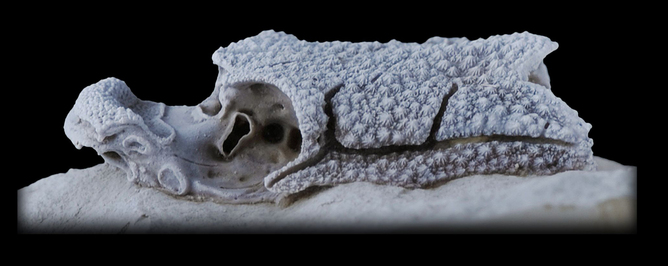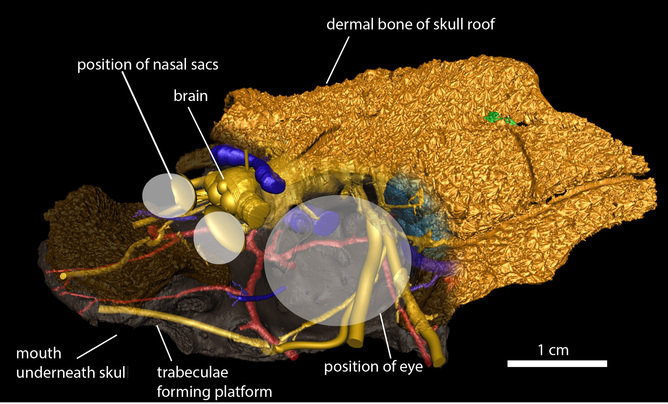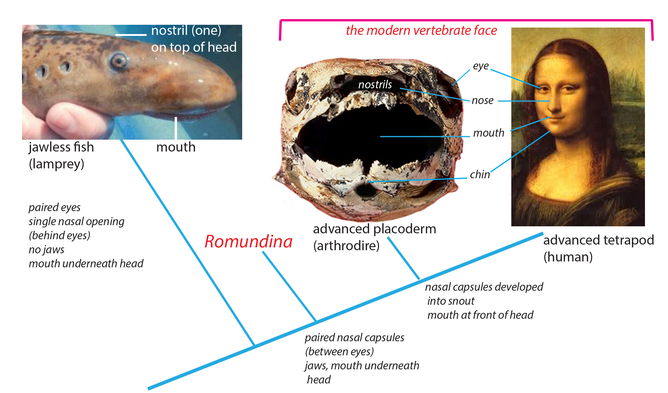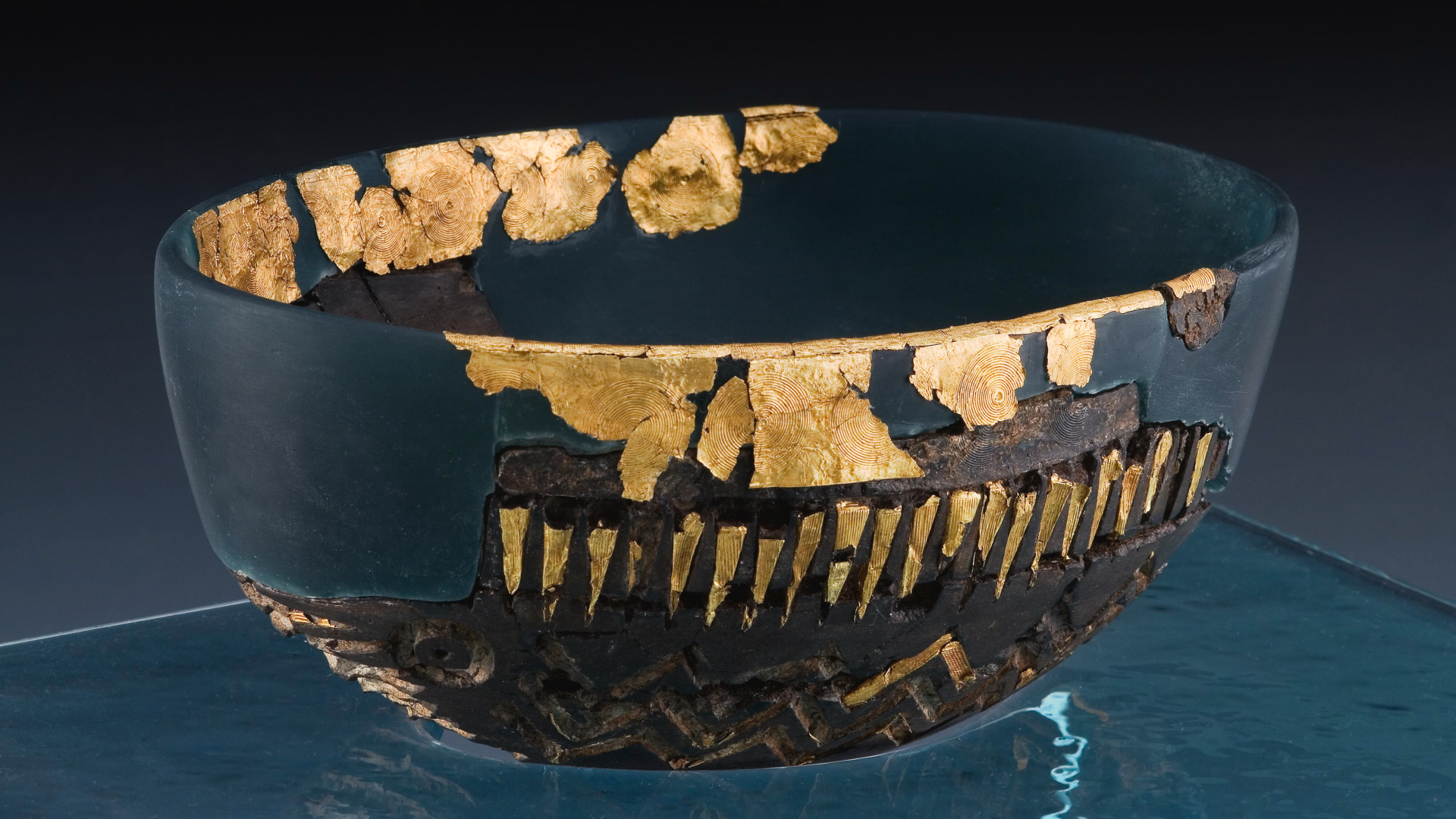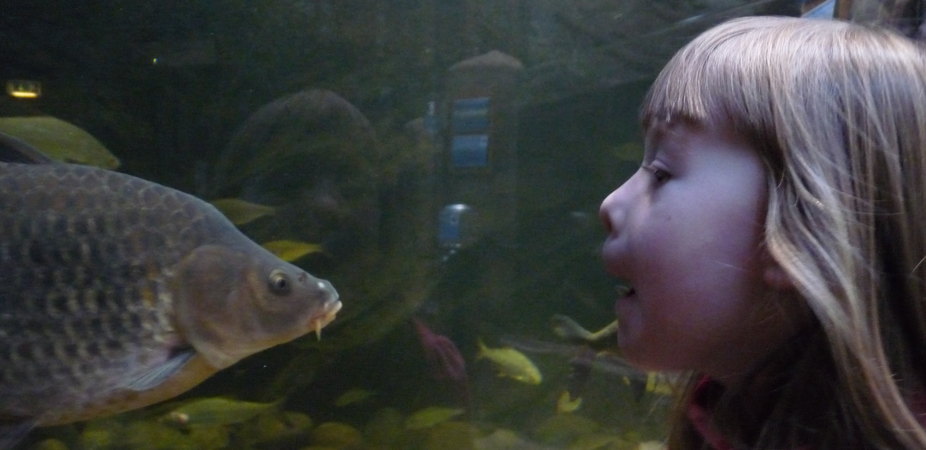
This article was originally published at The Conversation. The publication contributed the article to Live Science's Expert Voices: Op-Ed & Insights.
Let's face it – without a face no-one would recognise us, nor would we be able to guess what others might be thinking or feeling.
Faces and their subtle degrees of symmetry and expression have defined human beauty and tragedy throughout past millennia of art and drama.
Faces, though, are not uniquely human, but are a shared feature with all back-boned animals (vertebrates), from sharks to squirrels. So when and where did the face first acquire its modern, recognisable shape?
A paper published today in Nature announced that the face had its origins deep within extinct armoured fishes called placoderms.
We are all derived from placoderms
Placoderms were really gnarly armoured fishes that ruled the oceans, rivers and lakes of the world from about 440-360 million years ago. They were the first animals to evolve jaws and teeth, a truly landmark event in evolution that denotes the beginning of the lineage leading to sharks, bony fishes, amphibians, reptiles and mammals.
Indeed much of the human body plan took shape from these armour-plated fishes. Placoderms have given us many evolutionary legacies including paired hind limbs, mating by copulation, paired bony plates forming the skull, and even the modern inner ear with three semicircular canals.
Get the world’s most fascinating discoveries delivered straight to your inbox.
A new study by a team of French and Swedish scientists led by Dr Vincent Dupret, of the University of Uppsala, now builds upon recent work published in late 2013 in Nature on a “missing link” placoderm fish from China called Entelognathus.
This was the first creature to have evolved a suite of bony upper and lower jaw bones similar to those in tetrapods, four legged animals like reptiles and mammals. This spectacular fossil fish rooted placoderms firmly at the base of the tree containing all higher vertebrates, including us.
An old fossil revealed by new technology
The new paper takes the evolutionary story a big step further back to an even more primitive placoderm, named Romundina. This fish was discovered in the early 1970s from an island in Arctic Canada and the 2-3cm long skulls were prepared out of the limestone rock using dilute formic acid to dissolve the rock away.
First studied and named in 1975 by Norwegan palaeontologist Tor Ørvig (1916-1994), Romundina was one of the first examples of a very well-preserved 3D early placoderm fossil. It has been used in many studies of early vertebrate evolution, but up until now the detailed internal cranial anatomy remained unknown.
Dr Dupret told me he began the work to get practise working with 3D scanning software and the more he delved into the tiny skull’s anatomy the more interesting it became.
“Watching the complete 3D model of this tiny fossil with all structures reconstructed – the nerves, blood vessels, and so on – is a big thing,” Dr Dupret said.
“But then realising that it is like watching a ‘mirror to the past’, staring back at you, with some structures close to ours, while other are closer to jawless vertebrates, is a little like Prince Hamlet looking at Yorick’s skull!”
Using advanced synchrotron imaging, the delicate 3D skull of this fish readily gave up its innermost anatomical secrets to the intense beam from the European synchrotron in Grenoble. The results are breathtaking for any biologist: a detailed 3D map of the cranial cavities revealing how the brain, sensory structures,nerves and arteries were positioned and proportioned.
A synchrotron tomography movie showing the internal anatomy of the 400 million year placoderm Romundina. The outer bone dissolves away to reveal the reconstructed shape of the brain, nerves and circulatory system. Dr Vincet Dupret, University of Uppsala.
How placoderms gave us the modern vertebrate face
The new work found that the internal skull anatomy of the fish retained a number of primitive characteristics found only in jawless fishes, such as the lamprey and a number of extinct fossil forms.
The short nasal capsules situated between the eyes is such an example, as in later placoderms and all subsequent animals, the nose develops in front of the face. But what enabled the paired nasal capsules to move out to the front of the skull?
The study suggest that inside the head of Romundina an area of tissue developed from the braincase into a flat platform formed by cartilages called trabeculae. These first evolved in ancient armoured jawless fishes such as Shuyu but are more extensively developed in Romundina.
They give support to the front part of the brain (telencephalon) as it extended forwards to grow into large paired nasal capsules. This would have enabled fishes, and all later vertebrates, to develop a keen sense of smell, a necessary ability to help find prey and sense predators.
Beauty is often talked about in terms of symmetry and placement of human facial features. A beautiful face is one of perfect symmetry.
Just imagine then if our faces hadn’t evolved further from the Romundina condition. We would have our nostrils opening between our eyes.
After Romundina, placoderms developed proper noses with paired nostrils opening from a snout protruding in front of the eyes. In later placoderms, such as Entelognathus, the mouth become covered with an outer row of flat bones which then fixed the position of eyes, nose and mouth within the vertebrate skull from this point onwards.
A bone of contention
The new paper presents one result that not all palaeontologist will agree with. The phylogenetic analysis, showing the relationships of the various placoderm groups, presents a radical hypothesis about the sequence of character acquisition in the group. Every major paper on the subject in the past five years in Nature gives a completely different result of the relationships of the various placoderm families.
To me this suggests that much further work needs to be done to resolve the relationships of these placoderm groups. This is important work as it will give us a better understanding of the timing and sequence of appearance for the facial and other characters in the grand narrative of modern vertebrate evolution.
Fortunately Australia has some of the world’s best fossil sites of this age at Gogo in the Kimberely, and Taemas-Wee jasper in NSW. We have several new, spectacular placoderm skulls preserved in 3D that my colleagues and I are currently working on using microCT and synchrotron imaging. We hope these discoveries will help resolve some of these critical issues in evolution.
Charles Darwin’s book on The Expression of the Emotions in Man and Animals (1872) first announced that our facial expression are not unique to humans, but are a shared trait within the animal kingdom.
From today’s paper we now know that the origin of the face, at least in terms of the symmetry and placement of eyes, nose and mouth, is another hallmark feature that first evolved in ancient placoderms, now passed on to us humans, through the gift of evolution.
John Long receives funding from the Australian Research Council.
This article was originally published on The Conversation. Read the original article. The views expressed are those of the author and do not necessarily reflect the views of the publisher. This version of the article was originally published on Live Science.

John Long researches the early evolution of vertebrates in order to unravel the stages of how the modern vertebrate body plan evolved. He has served as the Vice President of Research and Collections at the Natural History Museum of Los Angeles County, Head of Sciences at Museum Victoria and as Curator of Vertebrate Palaeontology at the Western Australian Museum. Long has conducted field work collecting fossils in Australia, Antarctica , Southeast Asia, The US, Iran, South Africa and China. He is also author of some 30 adult and children's books, including non-fiction and fiction.

